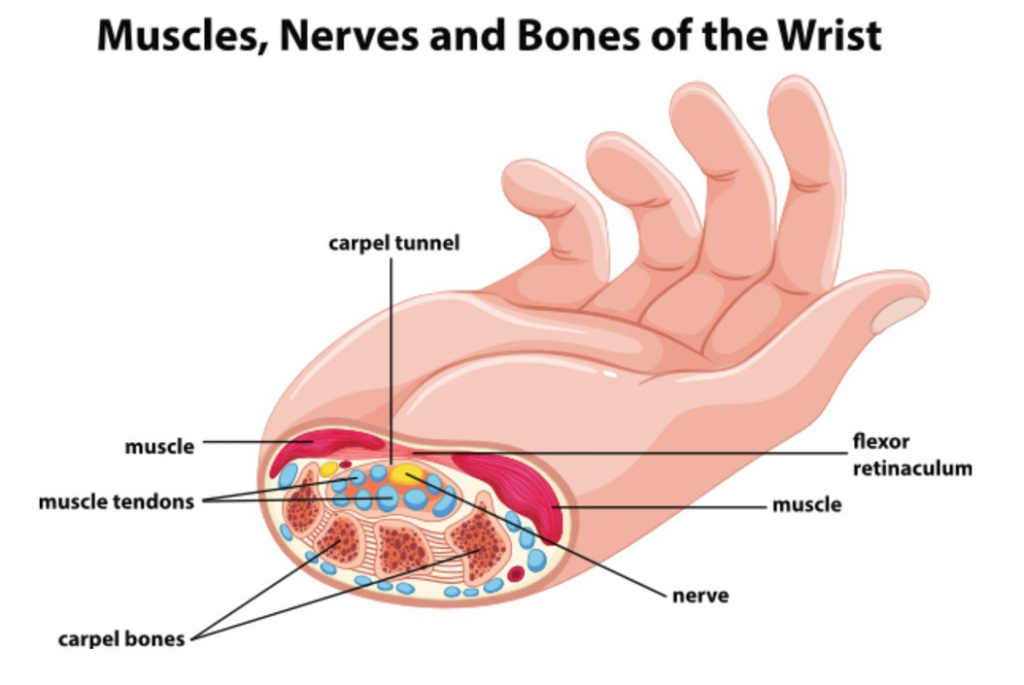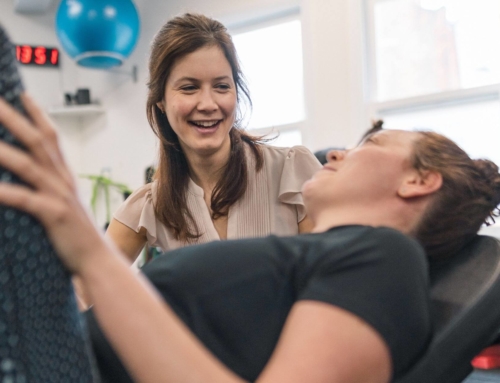What is Carpal Tunnel Syndrome (CTS)?
Carpal tunnel syndrome is a common condition that classically causes symptoms of numbness, tingling, pins and needles, and pain in the hand, fingers, thumb and wrist.
The condition occurs when one of the main nerves that supplies the hand (the median nerve) is squeezed or compressed as it travels through the wrist. The median nerve supplies feeling to the thumb, index, middle finger, and the ring finger, which means that the little finger is not usually affected. The nerve also controls the movement of the small muscles at the base of the thumb, and therefore people sometimes also report weakness in the thumb and wrist.
Anatomy
There are eight small bones in the wrist called the carpal bones. A ligament called the flexor retinaculum, lies across the front (palm aspect) of the wrist. This ligamentous band is a strong, fibrous structure that covers the carpal bones. Between this ligament and the carpal bones is a space called the carpal tunnel.
The nine flexor tendons that bend the fingers and thumb travel through the carpal tunnel before attaching onto the bones of the fingers.
The median nerve is one of the main nerves in the hand. It originates as a group of nerve roots in the neck; these roots then come together to form a single nerve in the arm. The median nerve then travels down the upper arm, across the elbow, and into the forearm, then passes through the carpal tunnel at the wrist on its way to the hand and fingers.
It is the median nerve that is the main structure involved in CTS.

Where it says nerve can you add median on top so it says Median nerve
What Causes Carpal Tunnel Syndrome?
Carpal tunnel syndrome is one of the most commonly reported nerve entrapment conditions. The carpal tunnel has little capacity to stretch or increase in size due to the rigid structures that create it; this means that any irritation or swelling within the tunnel causes pressure on the median nerve.
There are two ways in which the carpal tunnel is affected:
- The tunnel space can be reduced due to swelling around the wrist – this might be due to arthritis in the wrist, wrist injury, or peripheral swelling during pregnancy.
- If the structures within the tunnel enlarge, this will reduce the tunnel space – such as inflammation of the wrist tendons from repetitive movements of the hand and wrist.
Risk Factors of Carpal Tunnel Syndrome
Research into exactly what causes CTS is still ongoing, however there are a number of risk factors that make you more susceptible to developing the condition.
These Risk Factors include:
Joint conditions – osteoarthritis or rheumatoid arthritis.
Injury to the wrist such a sprain or fracture.
Jobs that require excessive computer work and typing.
Manual jobs such as butchers, chefs, electricians, carpenters.
Pregnancy – this may be due to the associated hormonal changes and fluid retention.
Musicians, especially pianists.
Medical conditions such as diabetes and thyroid problems.
Family history of CTS.
Obesity – those with an increased BMI
What are the Symptoms of Carpal Tunnel Syndrome?
In most cases Carpal Tunnel Syndrome (CTS) sufferers will usually experience a gradual onset of symptoms, which are often sporadic and intermittent initially, without any specific injury. As the condition worsens, symptoms may occur more frequently or persist for longer periods of time. Symptoms are often worse at night, and are exacerbated by activities which involve movement of the wrist and hands – typing, gripping, driving, holding a book or newspaper.
Occasionally, but not that commonly, there is evidence of weakness and muscle wastage of muscles at the base of the thumb, which can cause loss of hand function, clumsiness and reduce pincer grip of the finger and thumb.
Many patients find that moving or shaking their hands helps relieve their symptoms.
These are the most common symptoms:
- Numbness, tingling, pins and needles — primarily in the thumb, index, middle, and ring fingers.
- Pain – often a burning type pain
- Night symptoms – symptoms are often worse at night. Pain and pins and needles often wakes people several times at night..
- Occasional pain or tingling that travels up the forearm toward the shoulder
- Weakness and clumsiness in the hand — this may make it difficult to perform fine movements such as holding a cup or doing buttons or zips.
- A feeling of swelling in the fingers and wrist

The symptoms of carpal tunnel syndrome can be similar to other medical conditions or problems, so it is always important to see a healthcare professional for an accurate diagnosis. Early assessment and treatment is important to avoid long term damage to the median nerve.
If you are suffering from any of the symptoms above or are concerned that you might have CTS then please contact us to book an appointment on 0207 4823875 or email info@complete-physio.co.uk.
How is Carpal Tunnel Syndrome Diagnosed?
A diagnosis of CTS is based on a thorough clinical assessment, carried out by one of our expert Physiotherapists. They will take a detailed subjective history of your symptoms and also carry out a physical examination.
All our clinicians are highly experienced in diagnosing and treating Carpal Tunnel Syndrome.
Clinical Assessment
Your physiotherapist at Complete will carry out a series of clinical tests to confirm your diagnosis; this may include:
- Assessing your range of movement in your wrist, hand and fingers.
- Carrying out tests to identify weakness in the muscles supplied by the median nerve in the hand, including some thumb muscles that are often affected by the syndrome.
- It is also essential to thoroughly examine your neck and back, and test the mobility of your median nerve throughout your upper limb.
There are 2 special tests that your therapist will likely perform:
- Tinel’s sign: In this test, tapping on the wrist, over the median nerve with a finger or reflex hammer may cause tingling or an electric shock-like sensation in the fingers.
- Phalen’s test: Bending the wrist at a 90-degree angle, with your elbow resting on a table for one minute. This may cause symptoms to appear in the hand if an individual has carpal tunnel syndrome. The more quickly symptoms appear, the more severe the carpal tunnel syndrome.
It is also important to rule out other conditions that can mimic the symptoms of carpal tunnel syndrome; such as issues in the neck which can cause compression of a nerve, resulting in pain, pins and needles and numbness in the wrist and hand – very similar to that of CTS.
Will I Need a Scan?
A scan is not required to diagnose CTS. If your physiotherapist is not completely certain of your diagnosis, there are a number of other tests that can be carried out.
At Complete Physio our clinical specialists use diagnostic ultrasound scans to visualise the median nerve and diagnose the condition. CTS causes swelling of the median nerve, which can be easily identified on diagnostic ultrasound. Other abnormalities of the tendons and/or ligaments within the carpal tunnel and surrounding structures can also be identified. The scan can also help to determine why the median nerve is being compressed, for example, it can identify inflammation of the tendons or thickening of the ligament which forms the carpal tunnel, which might be the underlying cause of the compression.
They will compare your affected side to your non affected side to help confirm the diagnosis. Ultrasound has been shown to be as accurate as nerve conduction studies for the diagnosis of carpal tunnel syndrome.

X-rays of the wrist may be ordered if there is limited wrist motion, or evidence of arthritis or trauma.
MRI is rarely required to diagnose Carpal Tunnel Syndrome.
How Do We Treat Carpal Tunnel Syndrome?
Patient Education, Rest and Activity Modification.
You will be given a clear explanation of your diagnosis and the cause of your symptoms, as well as advice on how you can help to self manage your symptoms. Resting from the aggravating cause is essential, and you will likely need to modify some of the activities that you do, in order to rest your wrist and allow your pain and symptoms to settle.
Advice on Pain Management
You may benefit from painkillers or anti-inflammatory medication, such as Ibuprofen. This should be discussed with your GP or pharmacist.
Wrist Splints
Your physiotherapist may recommend that you wear a wrist splint for a couple of weeks, this is usually recommended for nighttime to keep the wrist in a neutral position, which will reduce the compression on the median nerve. This should allow adequate time for the inflammation and swelling to settle down and symptoms to reduce.

Physiotherapy
Physiotherapy is extremely beneficial for most carpal tunnel sufferers, especially in mild to moderate cases.
Your physiotherapy will likely include:
- Mobilisations of the carpal bones in the hand and gentle stretching of the flexor retinaculum to try and “open up” the carpal tunnel.
- Nerve and tendon gliding exercises to ensure full, unrestricted mobility of these structures.
- Muscle and soft tissue massage to the upper limb, especially the forearm muscles which can often be tight and sore.
- Gentle spinal (cervical and thoracic) joint mobilisations to ensure these areas are not contributing to your symptoms.
- Upper limb, wrist and hand range of movement exercises to ensure good joint movement.
- Extensive strengthening and endurance exercises for the larger, stability muscles of the shoulder girdle.
- Strengthening exercises for the forearm, wrist and hand, including fine motor and hand dexterity exercises.
- Thumb strengthening work – these are the muscles that the median nerve supplies, and therefore are often affected.
Ergonomic Assessment

Excessive computer and laptop use is one of the main contributing factors that we see in carpal tunnel Syndrome. If your symptoms have started as a result of prolonged sitting at a desk, we would advise you to get a workstation assessment to help reduce your symptoms and prevent recurrence. This is an essential part of your treatment regime.
Are steroid injections effective for Carpal Tunnel Syndrome?
An ultrasound-guided steroid (also known as cortisone) injections can be extremely effective for the treatment of carpal tunnel syndrome if your symptoms are not settling with physiotherapy alone. An injection is a reasonable next step before considering surgery. Steroid injections are recommended for carpal tunnel syndrome by the National Institute for Health & Care excellence (NICE).
Our Clinical specialists at Complete Physio are fully trained to provide ultrasound guided injections. This service is self referral i.e. no GP referral is required. The process involves injecting the steroid (also known as corticosteroid or cortisone) next to the nerve in the carpal tunnel using ultrasound guidance. This technique provides high precision and accuracy, maximising the effectiveness of the treatment, and consequently reducing potential complications and side effects. Research has shown that using ultrasound guidance also reduces the pain associated with the procedure. Corticosteroid is an extremely safe and strong anti-inflammatory medicine. It is the most commonly used treatment for CTS. At Complete we have been carrying out these pain killing injections for many years, and offer this unique service at an affordable price to our patients.
For more information or to make an appointment please do not hesitate to contact us on 020 7482 3875 or email us on info@complete-physio.co.uk. If you would like to speak to one of our clinicians before booking in then let us know and someone will call you back asap.
Surgical Treatment for Carpal Tunnel Syndrome?
Surgery for CTS is always reserved for the most severe cases that have not improved with conservative treatment including guided steroid injections.
The first carpal tunnel surgery was performed in the 1930s. It is a procedure that has been well recognised in the surgical field for over 50 years.
There are two types of surgery for CTS, open release surgery as well as endoscopic, which is a minimally invasive technique. Both of which involve cutting a ligament around the wrist, to open up the carpal tunnel and reduce the pressure on the median nerve.
At Complete Physio we work with some of the county’s most highly experienced and skilled surgeons, so we will ensure that you are referred to the most appropriate consultant for you. Although the surgery is very short (20-30 minutes), the recovery time is usually between 4-6 weeks and you will need to have further physiotherapy at Complete in order to maximise your recovery.
For further information or to book an appointment please do not hesitate to contact us via email at info@complete-physio.co.uk or call 020 7482 3875.
Don’t let pain hold you back, book now!




